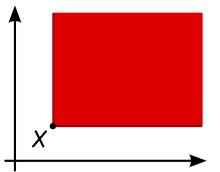Ordered vector space

In mathematics, an ordered vector space or partially ordered vector space is a vector space equipped with a partial order that is compatible with the vector space operations.
Definition
Given a vector space V over the real numbers R and a preorder ≤ on the set V, the pair (V, ≤) is called a preordered vector space if for all x, y, z in V and 0 ≤ λ in R the following two axioms are satisfied
- x ≤ y implies x + z ≤ y + z
- y ≤ x implies λy ≤ λx.
If ≤ is a partial order, (V, ≤) is called an ordered vector space. The two axioms imply that translations and positive homotheties are automorphisms of the order structure and the mapping x ↦ −x is an isomorphism to the dual order structure. Ordered vector spaces are ordered groups under their addition operation.
Positive cone
Given a preordered vector space V, the subset V+ of all elements x in V satisfying x ≥ 0 is a convex cone, called the positive cone of V. If V is an ordered vector space, then V+ ∩ (−V+) = {0}, and hence V+ is a proper cone.
If V is a real vector space and C is a proper convex cone in V, there exists a unique partial order on V that makes V into an ordered vector space such V+ = C. This partial order is given by
- x ≤ y if and only if y − x is in C.
Therefore, there exists a one-to-one correspondence between the partial orders on a vector space V that are compatible with the vector space structure and the proper convex cones of V.
Examples
- The real numbers with the usual order is an ordered vector space.
- R2 is an ordered vector space with the ≤ relation defined in any of the following ways (in order of increasing strength, i.e., decreasing sets of pairs):
- Lexicographical order: (a,b) ≤ (c,d) if and only if a < c or (a = c and b ≤ d). This is a total order. The positive cone is given by x > 0 or (x = 0 and y ≥ 0), i.e., in polar coordinates, the set of points with the angular coordinate satisfying −π/2 < θ ≤ π/2, together with the origin.
- (a,b) ≤ (c,d) if and only if a ≤ c and b ≤ d (the product order of two copies of R with "≤"). This is a partial order. The positive cone is given by x ≥ 0 and y ≥ 0, i.e., in polar coordinates 0 ≤ θ ≤ π/2, together with the origin.
- (a,b) ≤ (c,d) if and only if (a < c and b < d) or (a = c and b = d) (the reflexive closure of the direct product of two copies of R with "<"). This is also a partial order. The positive cone is given by (x > 0 and y > 0) or (x = y = 0), i.e., in polar coordinates, 0 < θ < π/2, together with the origin.
- Only the second order is, as a subset of R4, closed, see partial orders in topological spaces.
- For the third order the two-dimensional "intervals" p < x < q are open sets which generate the topology.
- Rn is an ordered vector space with the ≤ relation defined similarly. For example, for the second order mentioned above:
- x ≤ y if and only if xi ≤ yi for i = 1, ..., n.
- A Riesz space is an ordered vector space where the order gives rise to a lattice.
- The space of continuous functions on [0,1] where f ≤ g iff f(x) ≤ g(x) for all x in [0,1].
Remarks
- An interval in a partially ordered vector space is a convex set. If [a,b] = { x : a ≤ x ≤ b }, from axioms 1 and 2 above it follows that x,y in [a,b] and λ in (0,1) implies λx+(1-λ)y in [a,b].
See also
References
- Bourbaki, Nicolas; Elements of Mathematics: Topological Vector Spaces; ISBN 0-387-13627-4.
- Schaefer, Helmut H; Wolff, M.P. (1999). Topological vector spaces, 2nd ed. New York: Springer. pp. 204–205. ISBN 0-387-98726-6.
- Aliprantis, Charalambos D; Burkinshaw, Owen (2003). Locally solid Riesz spaces with applications to economics (Second ed.). Providence, R. I.: American Mathematical Society. ISBN 0-8218-3408-8.